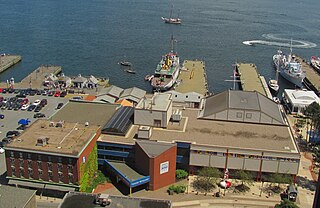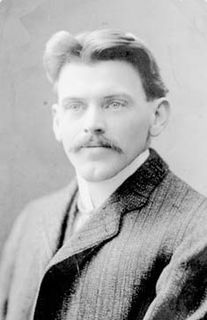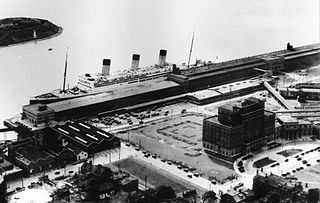Related Research Articles

Citadel Hill is a hill that is a National Historic Site in Halifax, Nova Scotia, Canada. Four fortifications have been constructed on Citadel Hill since the city was founded by the English in 1749, and were referred to as Fort George—but only the third fort was officially named Fort George. According to General Orders of October 20, 1798, it was named after King George III. The first two and the fourth and current fort, were officially called the Halifax Citadel. The last is a concrete star fort.

The Maritime Museum of the Atlantic is a maritime museum located in downtown Halifax, Nova Scotia, Canada.

Alexander Keith's is a brewery in Halifax, Nova Scotia, Canada. It is part of Anheuser-Busch InBev, a holdings company based in Leuven, Belgium, which owns over 400 beer brands globally.

Patrick Vincent Coleman was a train dispatcher for the Canadian Government Railways who was killed in the Halifax Explosion, but not before he sent a message to an incoming passenger train to stop out of range of the explosion. Today he is remembered as one of the heroic figures from the disaster.

Halifax Chebucto is a provincial electoral district in Nova Scotia, Canada, that elects one member of the Nova Scotia House of Assembly.

Pier 21 was an ocean liner terminal and immigration shed from 1928 to 1971 in Halifax, Nova Scotia, Canada. Over 1.5 million immigrants came to Canada through Pier 21, and it is the last surviving seaport immigration facility in Canada. The facility is often compared to the landmark American immigration gateway Ellis Island. The former immigration facility is now occupied by the Canadian Museum of Immigration, the Nova Scotia College of Art and Design as well as various retail and studio tenants.
The Naval Air Station Halifax, also NAS Halifax, was a United States Navy Naval Air Station located in Eastern Passage, Nova Scotia, Canada.

The Aspotogan Peninsula is a peninsula in the eastern part of Lunenburg County, Nova Scotia, separating St. Margarets Bay in the east from Mahone Bay in the west. The peninsula was originally settled by second generation French immigrants on the east side and by second generation German immigrants on the west side. Traditionally fishing was a major industry for communities throughout the peninsula, however other primary industries such as farming and forestry were historically important as well. Shipping and shipbuilding were secondary and tertiary industries that also came into prominence during the 19th and early 20th centuries.

Halifax Harbour is a large natural harbour on the Atlantic coast of Nova Scotia, Canada, located in the Halifax Regional Municipality.

The Westin Nova Scotian is a Canadian hotel located in Halifax, Nova Scotia, owned and operated by New Castle Hotels and Resorts. It was built in 1928 by the Canadian National Railway as the Nova Scotian Hotel and after several changes of owners and names in the late 20th century became the Westin Nova Scotian in 1996.

Hosting the region's largest urban population, Halifax, Nova Scotia is an important cultural centre in Atlantic Canada. Halifax is home to a vibrant arts and culture community that enjoys considerable support and participation from the general population. As the largest community and the administrative centre of the Atlantic region since its founding in 1749, Halifax has long-standing tradition of being a cultural generator. While provincial arts and culture policies have tended to distribute investment and support of the arts throughout the province, sometimes to the detriment of more populous Halifax, cultural production in the region is increasingly being recognized for its economic benefits, as well as its purely cultural aspects.
Lawlor Island or Lawlor's Island is a small island near the mouth of Halifax Harbour in Eastern Passage, Nova Scotia, Canada. It was the site of a major quarantine facility for immigration from 1866 to 1938 and is today owned by the Nova Scotia Department of Natural Resources as part of the McNabs Island provincial park reserve.

Halifax station is an inter-city railway terminal in Halifax, Nova Scotia, Canada operated by Via Rail.

The Halifax Seaport is a Canadian commercial development located on the Halifax, Nova Scotia waterfront, at the southern end of the Halifax Boardwalk. It is a re-use of former shipping warehouses. The intent of the multi-year project is to create a thriving new arts and culture district in the city.

Ruth Miriam Goldbloom,, , DLit was a Canadian philanthropist who co-founded the Canadian Museum of Immigration at Pier 21 in Halifax, Nova Scotia. She was born and raised in New Waterford, Nova Scotia, to immigrant parents. Their immigrant experience influenced her throughout her life and was a major factor in her helping to found Pier 21. She became the first Jew to Chair Mount Saint Vincent University's board, which was a Catholic women's university at the time. She was the chancellor of the Technical University of Nova Scotia in the 1990s and fundraising chair for the Halifax area United Way. She was inducted into the Order of Canada for her work with charities in the 1980s and 1990s.

The Bedford Magazine explosion was a conflagration resulting in a series of explosions from July 18 to 19, 1945, in Bedford, Nova Scotia, Canada. During World War II, the adjacent cities of Halifax and Dartmouth, provided heavy support for Canada's war effort in Europe.

Cambridge Military Library is a public library building in Royal Artillery Park in Halifax, Nova Scotia, Canada which was created in 1886. The building was created to house the garrison library collection, which had been moved from various locations in the city since its creation in 1817. It is the oldest library collection in Atlantic Canada. This building was the social and literary centre of military Halifax. In 1902, the officers of the garrison requested the library be named after the Prince George, Duke of Cambridge.

The Canadian Museum of Immigration at Pier 21, in Halifax, Nova Scotia, is Canada's national museum of immigration. The museum occupies part of Pier 21, the former ocean liner terminal and immigration shed from 1928 to 1971. Pier 21 is Canada's last remaining ocean immigration shed. The facility is often compared to Ellis Island (1892–1954), in terms of its importance to mid-20th-century immigration to Canada an association it shares with 19th century immigration history at Grosse Isle, Quebec (1832–1932) and Partridge Island in Saint John, New Brunswick (1785–1941). The Museum began as an independent institution run by the Pier 21 Society in 1999. It became a national museum run by the Canadian federal government in 2011.

RMS Lady Nelson was a steam turbine ocean liner which served in passenger service from 1928 to 1968 and operated as wartime hospital ship from 1943 to 1945. One of a class of five sister ships popularly known as "Lady Boats", she was built for the Canadian National Steamship Company (CNS). The five vessels were Royal Mail Ships that CNS operated from Halifax, Nova Scotia and the Caribbean via Bermuda. Lady Nelson was sold to Egyptian owners in 1953 and served as Gumhuryat Misr and Alwadi until she was scrapped in 1968.

The North Street Station was the railway terminal for Halifax, Nova Scotia from 1877 to 1920. It was built by the Intercolonial Railway in the North End of Halifax and was the second largest railway station in Canada when it opened in 1878. Damaged, but repaired after the Halifax Explosion, it served until the current Halifax terminal location opened as part of the Ocean Terminals project in the city's South End in 1919.
References
- ↑ Immigration Branch (Library and Archives Canada RG 76, Volume 666, File C1594, pt. 3)
- ↑ Dodge, Craig. Remembering Pier 2: Halifax's Other Immigrant Gateway, http://www.quai21.ca/sites/default/files/uploads/files/research_remembering_pier2.pdf
- ↑ Dodge, Craig. Remembering Pier 2: Halifax's Other Immigrant Gateway, http://www.quai21.ca/sites/default/files/uploads/files/research_remembering_pier2.pdf
- ↑ Immigration Branch (Library and Archives Canada RG 76, Volume 666, File C1594, pt. 3)
- ↑ "Royal Canadian Navy: Naval Reserve Division". www.facebook.com. Retrieved 23 June 2017.
| This Nova Scotia–related article is a stub. You can help Wikipedia by expanding it. |
| This Canadian history article is a stub. You can help Wikipedia by expanding it. |
Coordinates: 44°39′10″N63°34′40″W / 44.652773°N 63.577845°W